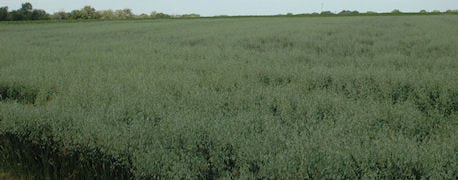April 1, 2013

A mostly forgotten crop could be an economical way to boost hay supplies for your cattle. Bruce Anderson, University of Nebraska-Lincoln forage specialist, say hay supplies are down and many hay fields are thin this spring.
"With little hay carryover, hay fields thinned by drought, and pastures also weakened by
drought, growing extra forage this spring might be wise," Anderson says. "I think oat forage could be more important than ever this spring.
"Oats grows during cool spring weather when we are most likely to receive some rain and when soil moisture is used most efficiently to produce forage. So risk is low and
seed is relatively cheap. Plus, you can use oats several ways."

Boost Hay Supplies For Cattle By Planting Oats
Oat hay is ideal for young livestock if the oats is cut just when it begins to head out. Or, he suggests, you can increase yield by about one-third and cut oats in the early milk stage for hay that's excellent for stock cows, he points out. Also, oats in the milk to early dough stage makes excellent silage.
If you get lucky and other hay fields yield enough so neither oat hay or silage are needed, you still can cut oats for grain and straw, Anderson says. Or, oats planted under irrigation can be cut for hay early enough to permit double cropping to soybeans or a summer annual forage crop, or even to corn for silage.
Drill three to four bushels of oats per acre into new fields for hay. With good soil moisture and 60 to 80 pounds of nitrogen, oats will produce two to three tons of hay for harvest in June.
"You also can thicken existing hay fields by drilling a bushel or two per acre as soon as possible directly into the existing crop," Anderson adds.
Other small grain crops are alternatives, too, he adds. Small grains planted last fall are green and will soon grow rapidly in most areas. Many fields are about ready to graze.
These small grain pastures are an extremely important resource this spring.
"Not only will they relieve you from feeding hay, get your animals onto clean green grass, and produce excellent gains, they also will help you wait longer before turning onto your other pastures, giving them a chance to recover from last year's drought stress," according to Anderson.
To maximize grazing from small grain pastures, wait until grass is 4 to 8 inches tall before starting to graze. Then stock heavily enough to maintain plant height between 6 and 12 inches. To accomplish this, either vary the number of animals according to grass growth or sub-divide the pasture into paddocks and graze rotationally.
Grass stands, soils, fertility, and moisture all will affect stocking rate, so adjust stock numbers for your conditions. With careful management, you can have good grazing all the way to mid-June.
One concern when grazing small grain pasture is animal death from grass tetany. Tetany is more common in lactating cows than in dry cows or young stock. Reduce tetany by feeding magnesium oxide supplements mixed with salt, molasses, or grain. Monitor consumption carefully and adjust the mixture so cattle consume about one-quarter pound of magnesium oxide per cow each week.
You May Also Like




